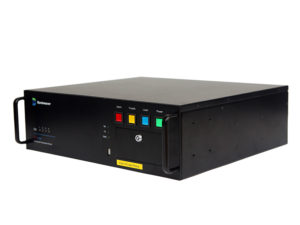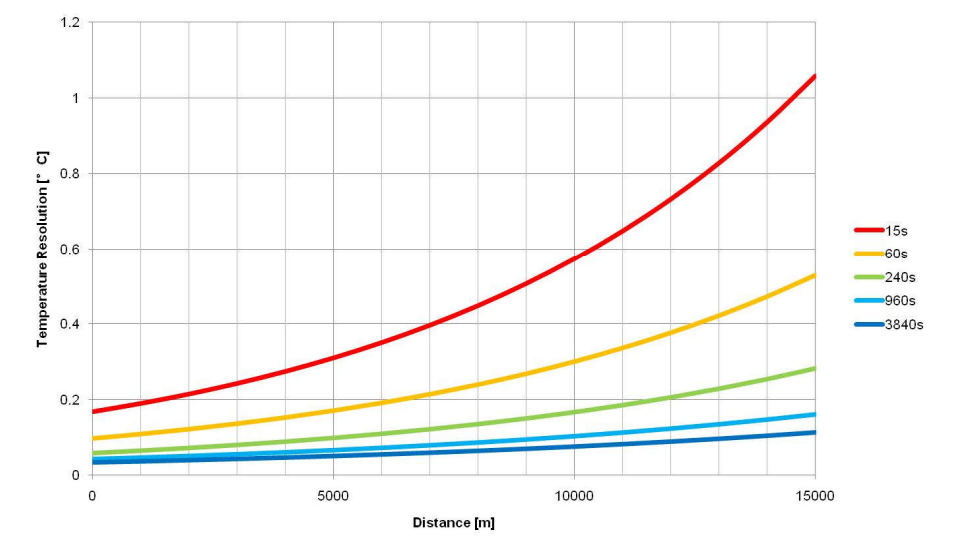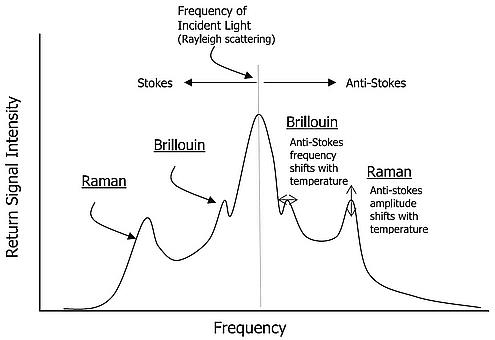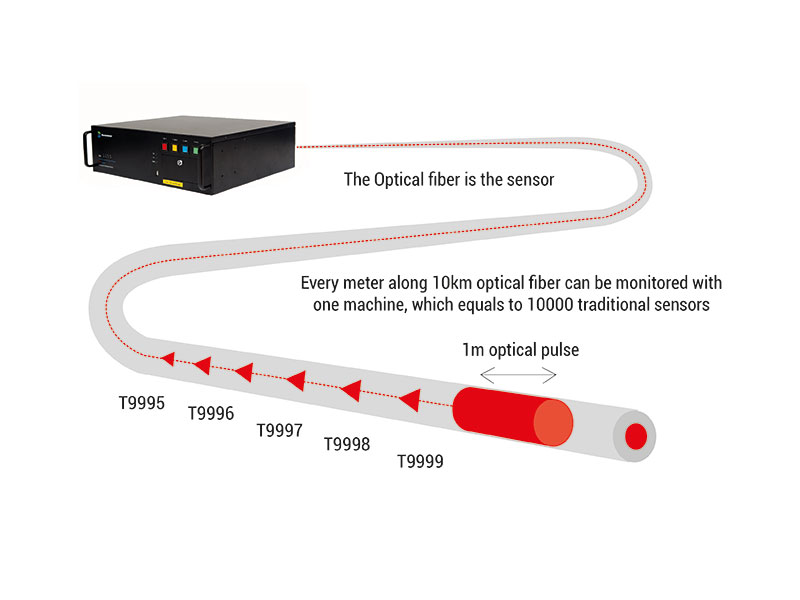Distributed Temperature Sensing System
Distributed temperature sensing systems (DTS) are fiber optic based optoelectronic instruments which measure temperature along the length of the fiber optic sensing cable. The unique feature of a distributed temperature sensing system is that it provides a continuous (or distributed) temperature profile along the length of the sensing cable and not at discrete sensing points which must be pre-determined.
DTS systems by Bandweaver
FireLaser – DTS
T-Laser – DTS
Fiber Optic Temperature Sensor How It Works
DTS systems contain a pulsed laser which sends in an approximately 1m pulse (equivalent to a 10ns time) into the fibre optic. As the pulse travels along the length of the fiber optic, it interacts with the glass. Due to small imperfections in the glass, a tiny amount of the original laser pulse is reflected back to towards the DTS sensing system. By analysing the reflected light the DTS is able to calculate the temperature of the event (by analysing the power of the reflected light) and also the location of the event (by measuring the time it takes the backscattered light to return) to typically within a metre.
DTS – Introduction to the Principles of Distributed Temperature Sensing
Discover the principles behind Bandweaver’s cutting-edge Distributed Temperature Sensing (DTS) technology.
Distributed Temperature Sensing Cable
Typically DTS technology uses a standard telecoms fiber optic cable and specialised cables or sensing points are only required if measurements are required at temperatures greater than 100°C. The sensing fiber is typically based on multimode fibers for shorter ranges (up to 40km) and single mode fiber for long ranges (40-100km).
Fiber Optic Temperature Measurement Specification For DTS
Distributed temperature sensing systems can typically locate the temperature to within a distance of 1m (this is known as spatial resolution) with accuracy to within ±1°C and with a sensing resolution down to 0.01°C. However, there is an inverse relationship with measurement resolution, range and sampling time i.e. the temperature resolution degrades with range and improves the longer time you acquire data for a specific measurement.

Temperature resolution performance of the Bandweaver T-Laser DTS
Distributed Temperature Sensing – Raman Measurement Principle
Fiber optics are made from doped quartz glass and when laser light is transmitted in a fiber optic an interaction occurs between the light particles (photons) and the electrons of the molecule. At a particular frequency in the electromagnetic spectrum (known as the Stokes and anti-Stokes bands), light scattering, also known as Raman scattering, occurs in the fiber optic. The intensity of the so-called anti-Stokes band is temperature-dependent, while the so-called Stokes band is practically independent of temperature. The local temperature of the optical fibre is derived from the ratio of the anti-Stokes and Stokes light intensities.

Profile with Rayleigh and Stokes Bands
Measuring Principle – OTDR And OFDR Technology
There are two basic principles of measurement for distributed sensing technology, Optical Time Domain Reflectometry (OTDR) and Optical Frequency Domain Reflectometry (OFDR).
OTDR was developed more than 20 years ago and has become the industry standard for telecom loss measurements. The principle for OTDR is quite simple and is very similar to the time of flight measurement used for radar. Essentially a narrow laser pulse generated either by semiconductor or solid state lasers is sent into the fibre and the backscattered light is analysed. From the time it takes the backscattered light to return to the detection unit it is possible to locate the location of the temperature event.

Alternative DTS evaluation units deploy the method of Optical Frequency Domain Reflectometry (OFDR). The OFDR system provides information on the local characteristic only when the backscatter signal detected during the entire measurement time is measured as a function of frequency in a complex fashion, and then subjected to Fourier transformation.
The vast majority of distributed temperature sensing systems available today is based on OTDR technology.
Advantages Of DTS Systems
Some of the unique features of distributed temperature sensing systems include:
- Excellent economies of scale. A system designer/integrator does not have to worry about the precise location of each sensing point hence the cost for designing and installing a sensing system based on distributed fibre optic sensors is greatly reduced from that of traditional sensors.
- Low maintenance and operation costs. The sensing cable has no moving parts and design lives of 30 years +, the maintenance and operation costs are considerably less than for conventional sensors.
- DTS sensing cables are immune to electromagnetic interference, vibration
- Safe for use in hazardous zones (the laser power falls below the levels that can cause ignition), thus making these sensors ideal for use in industrial sensing applications.
Fiber Optic Sensing Cable Design
The fibre optic cable is passive in nature and has no individual sensing points and therefore can be manufactured based on standard telecoms fibres and in many cases using standard telecoms fiber optic cable packaging.
In some cases specialised fiber optics are required and, similarly, specialised cable packaging. Some of the considerations which need to be taken into account when designing a distributed temperature sensing cable include:
- Temperature: Standard telecoms fiber optics and cable materials operate up to 100°C. Above this you will require specialised glass and cable materials. For example oil wells quite often exceed 200°C
- Mechanical Protection: Depending on the specific monitoring environment there might be high vibration or potentially crushing forces which will require additional layers of cable to provide protection to the sensing fiber
- Protection against hydrogen: In some environments there will be high levels of hydrogen which can cause the fiber optic to deteriorate (or darken). Some protection can be provided by using hydrogen scavenging gels – however for longer duration it is necessary to uses a specialised fiber optic itself which has specialised properties (dopants) within the core and cladding of the fiber optic.
Laser Safety And Operation Of System
When operating a system based on optical measurements such as optical DTS, laser safety requirements need to be considered for permanent installations. Many systems use low power laser design, e.g. with classification as laser safety class 1M, which can be applied by anyone (no approved laser safety officers required). Some systems are based on higher power lasers of a 3B rating, which although safe for use by approved laser safety officers, may not be suitable for permanent installations.
